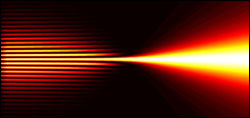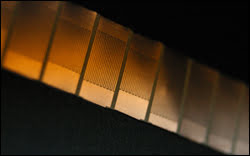
$13M UMich Center to Advance Nanophotonics
ANN ARBOR, Mich., Sept. 15, 2011 — A new $13 million National Science Foundation center based at the University of Michigan will enable the development of high-tech photonic materials that could promote advances in invisibility cloaking, nanoscale lasers, high-efficiency lighting and quantum computers.

An illustration of the subwavelength focusing of light by a so-called “near-field plate,” a device made of a metamaterial that was invented by physics professor Roberto Merlin and co-developed by electrical engineering associate professor Anthony Grbic. (Image: Roberto Merlin)
The Center for Photonic and Multiscale Nanomaterials, dubbed C-PHOM, involves engineering and physics researchers from the university's College of Engineering and College of Literature, Science and the Arts, as well from Purdue University and several other institutions.
The center has two thrusts: One group, led by professor Pallab Bhattacharya, will focus on improving wide bandgap semiconductors such as gallium nitride, which could make possible quantum emitters that release one photon at a time and could advance quantum computing and quantum information processing, vastly improving computer security. Because they could theoretically factor numbers dramatically faster than conventional computers, they could allow the creation of foolproof security codes. This research thrust also has applications in high-efficiency lighting and imaging.

Metamaterials such as this one developed by associate professor Anthony Grbic can focus light to specks smaller than their wavelength. Similar materials are being developed at the new Center for Photonic and Multiscale Nanomaterials. They have applications in wireless power transfer, high-resolution microscopes and even, potentially, invisibility cloaks. (Image: Cyan James)
A second group, led by professor Robert Merlin and researchers at Purdue, will aim to develop better metamaterials — uniquely engineered mixtures of substances that enable scientists to make light act in ways contrary to nature. Metamaterials make it possible to focus light to a speck smaller than its wavelength. They potentially could be used to bend light around objects and could also bring about ultrasubwavelength imaging that can see inside biological cells with unprecedented resolution.
“Advances in photonics depend critically on new materials, and this new center brings together top minds in electrical engineering, materials science and physics to focus on two of the most exciting new directions in materials for nanophotonics,” said Ted Norris, director of the new center. “The cross-campus collaboration will enable fundamental advances.”
For more information, visit: www.umich.edu
Published: September 2011